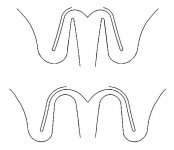Hi,
First off, I don't know a lot about audio 🙂 but I've been thinking about folded horns for a while now; the type mostly seen in megaphones, I think. In particular, what makes for a good fold.
As an example, how would you criticise the folds shown in the picture?
I struggle to get a feel for how the sound propagates through this type of horn. Do the sound waves reflect around the bends? Do they behave like a fluid?!
Are straight faces better or are the curvy bends going to perform better?
I believe the horns on the picture are both derived from Tractrix curves.
Your discussion is welcome! 😎
Mal.
First off, I don't know a lot about audio 🙂 but I've been thinking about folded horns for a while now; the type mostly seen in megaphones, I think. In particular, what makes for a good fold.
As an example, how would you criticise the folds shown in the picture?
I struggle to get a feel for how the sound propagates through this type of horn. Do the sound waves reflect around the bends? Do they behave like a fluid?!
Are straight faces better or are the curvy bends going to perform better?
I believe the horns on the picture are both derived from Tractrix curves.
Your discussion is welcome! 😎
Mal.
Attachments
Or do they do either depending on their wavelength. In any case, the more that gets around the bend the better.Do the sound waves reflect around the bends? Do they behave like a fluid?
I ask merely to find out people's opinions on what makes a good folded horn in terms of the bend sections. It just interests me because I can't fathom out the way to imagine the air waves going around the bends! 🙂 Having searched the internet I have yet to satisfy my curiousity on the topic.
I might want to make some at some point by 3D printing a design but I first want to know what would characterise a good design.
I might want to make some at some point by 3D printing a design but I first want to know what would characterise a good design.
The main advantage of a folded horn is a reduction in length and the main disadvantage is a reduction in bandwidth. This makes them an option for bass duty due to the length reduction achieved.
With 3-D printing your are limited to smaller parts implying a mid or treble horn. Keep in mind a re-entrant horn will not be suitable for high quality midrange or treble use.
With 3-D printing your are limited to smaller parts implying a mid or treble horn. Keep in mind a re-entrant horn will not be suitable for high quality midrange or treble use.
I think Bruce Edgar makes comments about folds in his 'Show Horn' article
http://volvotreter.de/downloads/Edgar-Show-Horn.pdf
http://volvotreter.de/downloads/Edgar-Show-Horn.pdf
Last edited:
I can't find a reference for this, but from memory:
A sharp bend in a horn will stop high frequencies from passing, in inverse proportion to the bend's cross sectional area. So if you want highs to get through the bend, it is better to position the bend near the throat, where the horn is skinny, rather than near the mouth.
For a DIY builder using ply, splitting a horn path in two (a W shape rather than a J shape) will halve the area of each horn path, so the same bend will allow more highs through. Splitting into 4 will be better again, and so on.
A standard commercial re-entrant horn (megaphones or the big metal ones) has taken that to it's logical extreme, and split the horn path into a full circle, and has already optimised the folding pretty well. They could get better HF response by moving the folds closer to the throat, but that would mean a longer horn, and space saving is the raison d'être of the re-entrant horn.
They usually sound bad. I imagine this is partly to do with the folds, and partly because of their expected use.
For Hi-FI, I think you'd be better off borrowing folding ideas from the Western Electric 15A rather than from a megaphone.
A sharp bend in a horn will stop high frequencies from passing, in inverse proportion to the bend's cross sectional area. So if you want highs to get through the bend, it is better to position the bend near the throat, where the horn is skinny, rather than near the mouth.
For a DIY builder using ply, splitting a horn path in two (a W shape rather than a J shape) will halve the area of each horn path, so the same bend will allow more highs through. Splitting into 4 will be better again, and so on.
A standard commercial re-entrant horn (megaphones or the big metal ones) has taken that to it's logical extreme, and split the horn path into a full circle, and has already optimised the folding pretty well. They could get better HF response by moving the folds closer to the throat, but that would mean a longer horn, and space saving is the raison d'être of the re-entrant horn.
They usually sound bad. I imagine this is partly to do with the folds, and partly because of their expected use.
For Hi-FI, I think you'd be better off borrowing folding ideas from the Western Electric 15A rather than from a megaphone.
- Status
- Not open for further replies.
- Home
- Loudspeakers
- Multi-Way
- Re-entrant Horns
